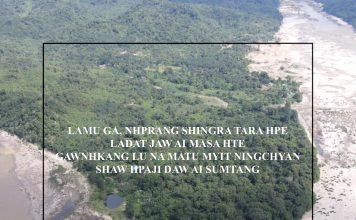Kachin State’s Indawgyi Lake, the largest lake in Myanmar’s and the third largest in Southeast Asia, was recently designated as a UNESCO Biosphere Reserve.
Biosphere reserves are importantly biodiverse areas where UNESCO (The United Nations Educational Scientific and Cultural Organisation) believes that with proper management biodiversity can be conserved while the local population is sustainably supported.
According to UNESCO: “A biosphere reserve is a unique kind of protected area that differs from a national park, wilderness area, national forest, or wildlife refuge in having three very different, but equal, aims: conservation of genetic resources, species, and ecosystems; scientific research and monitoring; and promoting sustainable development in communities of the surrounding region.”
According to UNESCO: “Each reserve promotes solutions reconciling the conservation of biodiversity with its sustainable use.”This could include things like education, management, study and preservation of ecological systems and conflict management amongst other things.
There are 669 biosphere reserves in 120 countries, the only other one in Myanmar is Inle Lake, which was granted biosphere reserve status in December 2015.
In February 2016 the Indawgyi Wildlife Sanctuary was also declared a Ramsar Site, one of 2,231 wetland sites in 169 countries designated as being of international importance under the Ramsar Convention.
Indawgyi Lake lies in the hills about 175 kilometres southwest of the Kachin State capital Myitkyina.
The lake itself is about 24 kilometres long and about 10 kilometres wide, it is surrounded by hills covered with forest. The biosphere reserve is an area of 133,715 hectares that includes the lake and the surrounding wetlands and forest to a distance of about 15 kilometres.
About 35,000 mainly Kachin and Red Shan people live in 13 villages within the biosphere reserve. Most of those people depend on fishing and rice farming for their livelihoods.
In the last few years, prior to being declared as a Ramsar Site and biosphere reserve Indawgyi was one of the most studied wildlife habitats in Myanmar.
The lake is home to 93 different species of fish, six of those species are new to science.They were only discovered in the last few years and have so far only been found in Indawgyi Lake. The lake is also home to many species of turtles, five of which are globally threatened.
Over 160 species of birds have been recorded in the area, including many globally threatened species and ten species under threat of extinction.The lake is also an important stopover point for birds migrating along the East Asian to Australasian migration route, which extends from Arctic Russia and North America to the southern limits of Australia and New Zealand and supports more migrating water bird species and a higher proportion of globally threatened bird species than any other migration route.
Living around the lake there are also endangered mammals such as Eastern Hoolock Gibbons, Shortridge Langurs, Asiatic Black Bears, Hog Deers, and Gaurs.
According to UNESCO Indawgyi Lake is relatively unpolluted. A UNESCO document proposing the area for biosphere Reserve status said: “Overall water quality is good. Rice cultivation currently does not apply pesticide, herbicide, or significant quantities of fertilizer that would diminish water quality,” though the same document says management of human waste needs to be improved.
Despite Indawgyi and the surrounding watershed and wetlands being one of Southeast Asia’s most intact landscapes there are still problems. The international environmental organisation Fauna and Flora International (FFI), warned in a press release: “Unless agriculture and forests are managed sustainably, the lake ecosystem will suffer from run-off caused by erosion triggered by agricultural encroachment or unsustainable logging in the watershed. If farmers use excessive amounts of fertilizers and pesticides the lake becomes polluted and collapses.”







